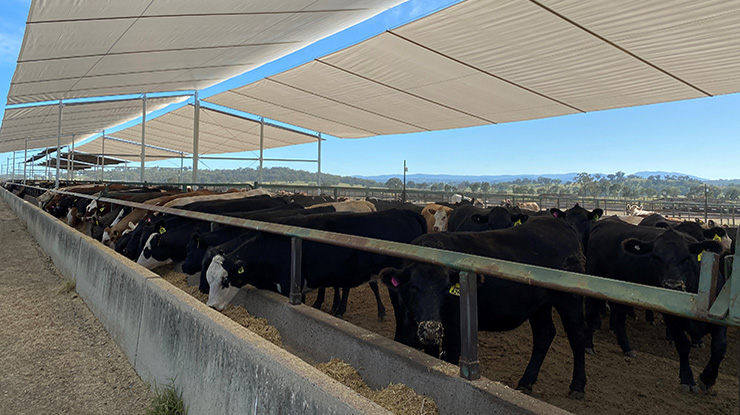R&D update: shade and covered housing in Australian feedlots
15 August 2022

Cattle at the University of New England’s Tullimba feedlot in treatment group three, under partial pen coverage with waterproof system (4 m2/head)
To support the Australian Lot Feeders’ Association goal of all feedlots having access to shade by 2026, MLA is currently investing in a range of research and development activities.
These include evaluation of shade and shelter in temperate environments, guidelines for covered housing systems, evaluating partial pen coverage with shelter in a commercial feedlot, and development of an odour model for covered housing facilities.
Shelter benefits performance and welfare in New England trial
An MLA-supported project conducted by Dr. Angela Lees at the University of New England Tullimba feedlot has evaluated the effect of shade during summer, as well as partial pen coverage with shelter in winter, on feedlot cattle performance and welfare.
After record rainfall over the last year, Dr. Lees hypothesised that keeping cattle dry, clean, and comfortable would maximise feedlot productivity and welfare.
For the summer study, a total of 720 Bos taurus heifers were randomly allocated to three treatment groups: 1) unshaded; 2) shade cloth (shaded 2.8 m2/head); and 3) partial pen coverage with waterproof system (4 m2/head). Six pen replicates of 40 head each were fed. Cattle were unbedded for the duration of the research trial.
Key findings of the summer study included:
- Partial pen coverage with a waterproof system provided significant productivity benefits increased average daily gain (+100g/hd/day), feed efficiency (4%) and hot standard carcase weight (7kg) during the summer experiment.
- There was no difference in performance between the shaded and unshaded treatments, most likely reflecting the mild and wet summer conditions.
- During very hot conditions (heat load index ≥ 86), waterproof cattle and shade cloth treatments had lower mean panting scores when compared to unshaded cattle indicating improved animal comfort.
In the winter study, a total of 480 Bos taurus steers were randomly allocated to either 1) unshaded or 2) partial pen coverage with waterproof system (4 m2/head). Six pen replicates of 40 head each were fed. Cattle remained unbedded for the research trial.
- Partial pen coverage with waterproof shelter again significantly improved ADG (100g/day) and feed efficiency (5.3%); and tended to improve HSCW (5kg).
- Adrenal gland weight an objective measure of chronic stress was greater in unshaded pens.
The outcomes from this project suggest that implementing a partial shelter solution can result in productivity and animal welfare benefits providing an option for Australian lot feeders interested in installing shelter to existing open pen facilities or for new developments into the future.
While shade cloth did not provide productivity benefits during mild summer conditions, it was noted that shaded cattle had lower panting scores compared to unshaded cattle during hot conditions, demonstrating improved cattle comfort.
Future R&D focused on impacts of shelter
Over the next few years, several R&D projects will further evaluate both fully and partially covered feedlot housing systems. These will include:
A best practice design and management guide for fully covered feedlots
Lot fed cattle welfare and production can be adversely impacted by extreme heat or cold, wet conditions if not managed appropriately. Covered housing systems may provide an economically viable means to address these concerns, while also improving public perceptions of welfare.
A new project to develop a best practice management guide for covered housing systems will explore the range of housing systems used in Australia and internationally for lot fed cattle and other intensive livestock.
The guide will include information on:
- design and materials
- stocking density
- pen cleaning frequency/bedding management
- lighting, ventilation and cooling requirements
- feeding considerations
- animal health implications
- manure and effluent management
- maintenance and lifespan
- changes in operational requirements and costs compared with uncovered systems
- benefits of covered systems over outdoor systems
- state and national regulatory requirements.
The practical guide will be illustrated with schematic drawings, photos and practical case studies. The project outcome will be an improvement in the design and management of covered feedlots that leads to better cattle welfare, productivity and environmental performance of cattle in covered facilities. The guide is expected to be published in mid-2023.
A project to evaluate partial shelter in a commercial feedlot
This project aims to build upon the results of the New England trial mentioned above on partial pen coverage with shelter. As part of this new project, cattle at a commercial feedlot will be provided with shelter in the form of a corrugated iron shed with a curved roof, and a ridge vent. The previous project provided 4m2 shelter per pen, and in this project 7.5 m2 shelter will be provided per animal in a pen stocked at 15 m2 per head. The project is due to commence in late 2022 and will run for 12 months. Results will be published in 2024.
A project to measure and model odour from covered feedlots to develop a nationally accepted odour measurement model for covered systems
With the increased interest in covered housing systems for lot fed cattle, it’s evident that there’s a lack of information on odour emerging from these types of facilities, which can delay or complicate development applications and approvals.
Generally speaking, odour emissions from feedlots are related to features such as depth of manure on the pen surface and moisture content. Covered housing systems remove the effects of rainfall, with odour mainly being driven by bedding management and stocking density.
It is thought that when managed effectively, covered housing systems have the potential to generate less odour. The aim of this project is to test this hypothesis, by undertaking odour measurements at a number of covered housing facilities, and subsequently developing a model that can be adopted by state regulators when assessing development applications for covered housing facilities.


